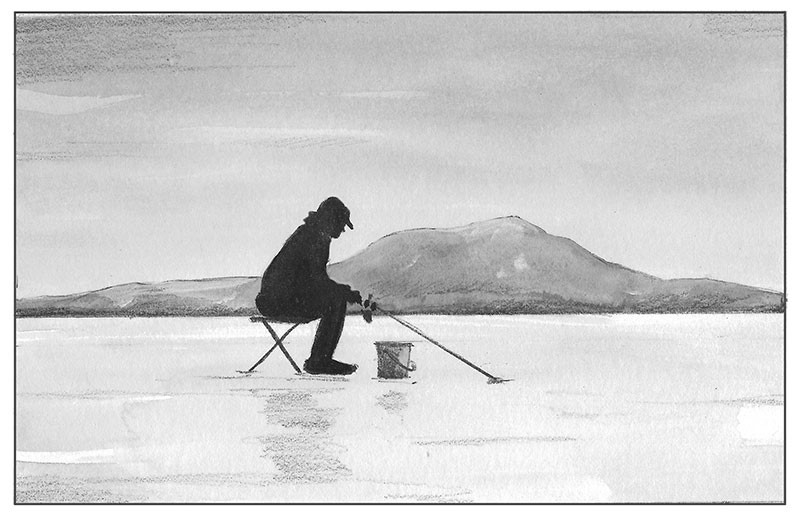
Come mid-January, when I’m acclimatized to Vermont’s winter, I enjoy an occasional stroll on the icy surface of Lake Champlain. I favor bays sheltered from the brunt of winter winds where the ice has had ample time to thicken. I pull microspikes on over my boots and off I go.
There’s room to roam between Burlington and the breakwater that parallels the shoreline. The lake ice locks spectacular natural art in place. Bubbles trapped under December ice are entombed as January’s ice forms below. Crystalline patterns resembling minute stars form during the various freezing and thawing cycles that occur as lake ice interacts with fallen snow.
While the winter air dries our skin, aquatic life goes on under the protection of the solid barrier – life that is possible because of a strange quirk in the physical chemistry of water. Most liquids shrink as they cool and eventually they become solid; the solid form continues to shrink as it continues to cool. The old mercury thermometers that have fallen from favor took advantage of this principle.
And if you use water to make a thermometer, it will work quite well, until that is, the water cools to 39.16 degrees Fahrenheit (4 degrees Celsius). Below that, water starts to misbehave, or at least behave differently than most other liquids. At 39.16 degrees, water shrinks to its most compact and dense form; any cooler and it starts to expand again and continues to expand as ice crystals form.
It is because of this strange expansion that ice cubes in your drink float. Because ice floats, our lakes freeze from the top and are frozen only near the surface. Sunlight and rising temperatures can thaw them from the top in spring. If Lake Champlain froze from the bottom to the full extent of its 400 foot depth, it would be impossible for sunlight and warm air to have much impact and much of the lake’s water would never thaw.
Lakes and seas that froze from the bottom would also mean that life on the bottom would have evolved very differently, if at all. Fish would have evolved ways to survive freezing, or would be extinct. The insects that spend winter months fattening up for a spring or summer hatch would not have that feeding opportunity. It is not an exaggeration to say that some strange chemistry of water has permitted life as we know it.
It is worth considering, therefore, what it is about water that makes this possible. Water, or H2O, is two hydrogen atoms attached to an oxygen atom by strong covalent bonds. These three atoms form a shape like a stubby boomerang, with the oxygen at the bend and the hydrogen atoms forming two arms. The boomerangs fly around in liquid water connecting and breaking weak hydrogen bonds as though the molecules were in a three dimensional game of tag. As the water cools, the boomerangs fly closer together and the water literally shrinks.
At just under 40 degrees, when the water is as dense as it can get, it stops shrinking and starts to expand again as it approaches freezing. At water’s freezing point, the hydrogen bonds become less transient and lock the boomerangs into hexagonal rings; attached together the rings look like a sheet of chicken wire. The rings have space in the middle, and so instead of being packed close together like in liquid water, each water molecule is close to just four adjacent molecules. The spacing of the molecules is so great that water expands about nine percent as it freezes, making ice buoyant on water. Umpteen identical sheets of these hexagons are bound together, face to face, building thickness until a near infinite number of hydrogen bonds can support ice shanties, trucks, and people out for a ramble.
Some things to consider as you bait your hook and drop a line through the ice: life started out in water more than three and a half billion years ago and only came ashore half a billion years back. How different might things be were it not for the strange behavior of the humble water molecule?


Discussion *